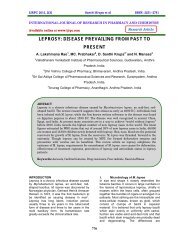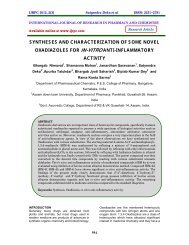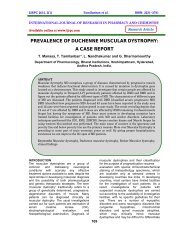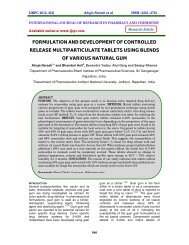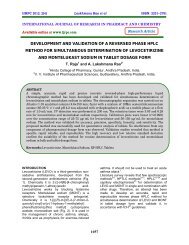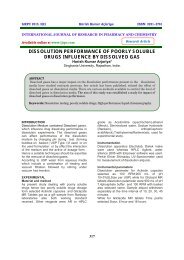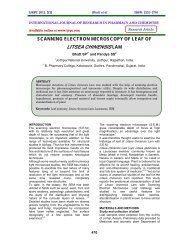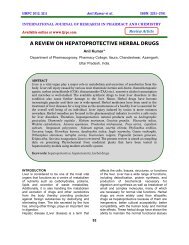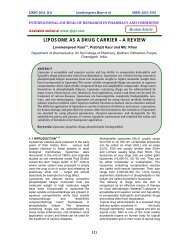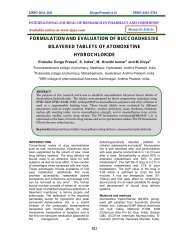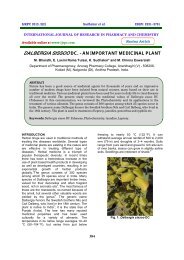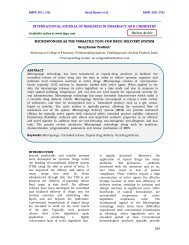preparation, characterization and evaluation of pgs - pvp co ... - ijrpc
preparation, characterization and evaluation of pgs - pvp co ... - ijrpc
preparation, characterization and evaluation of pgs - pvp co ... - ijrpc
Create successful ePaper yourself
Turn your PDF publications into a flip-book with our unique Google optimized e-Paper software.
IJRPC 2012, 2(3) Chowdary et al ISSN: 22312781<br />
Table 3: Physical Properties <strong>of</strong> Various Tablets Prepared<br />
By Direct Compression Method Employing<br />
PGS-PVP Co-processed Excipient<br />
Formulation<br />
Hardness<br />
(kg/sq.cm)<br />
Friability<br />
(% weight<br />
loss)<br />
Disintegration<br />
time<br />
(min-sec)<br />
Drug <strong>co</strong>ntent<br />
(mg/tablet)<br />
Efavirenz tablets 4.0 1.45 3-00 98.5<br />
Ritonavir tablets 5.0 2.10 3-15 99.2<br />
Stavudine tablets 5.0 1.95 3-20 101.6<br />
The results <strong>of</strong> the dissolution rate study are<br />
given in Table 4.With all the three drugs, the<br />
tablets prepared gave rapid dissolution <strong>of</strong> the<br />
<strong>co</strong>ntained drug. The dissolution was <strong>co</strong>mplete<br />
(100 %) within 20 min <strong>and</strong> fulfilled the <strong>of</strong>ficial<br />
(IP/USP) dissolution rate test specification<br />
prescribed in each case.<br />
Table 4: Dissolution Rate <strong>of</strong> Various Tablets Formulated by Direct<br />
Compression Method Employing<br />
PGS-PVP Co-processed Excipient Prepared<br />
Formulation<br />
Percent Drug Dissolved (%) at<br />
Time (min)<br />
5 10 15 20<br />
Efavirenz tablets 74.50 88.50 97.20 100<br />
Ritonavir tablets 78.40 98.80 99.90 100<br />
Stavudine tablets 71.62 100 100 100<br />
Official Dissolution Rate<br />
Specification<br />
NLT 70 % in 60 min in<br />
water <strong>co</strong>ntaining 2% SLS<br />
(I.P, 2010)<br />
NLT 75 % in 60 min in 0.1<br />
N HCl<br />
(I.P, 2010)<br />
NLT 70 % in 45 min in<br />
0.01 M HCl<br />
(I.P, 2010)<br />
CONCLUSION<br />
PGS-PVP <strong>co</strong>-processed excipient prepared by<br />
gelatinizing potato starch (49 parts) in the<br />
presence <strong>of</strong> PVP (1 part) is a crystalline,<br />
discrete <strong>and</strong> free flowing powder. It is insoluble<br />
in water <strong>and</strong> aqueous fluids <strong>of</strong> pH 1.2, 4.5 <strong>and</strong><br />
7.4 <strong>and</strong> in several organic solvents. It exhibited<br />
high swelling (284%) in water. PGS-PVP <strong>co</strong>processed<br />
excipient has excellent flow<br />
properties alone <strong>and</strong> as blends with selected<br />
drugs it exhibited excellent to good flow<br />
properties. Tablets <strong>of</strong> (i) efavirenz (ii) ritonavir<br />
<strong>and</strong> (iii) stavudine prepared by direct<br />
<strong>co</strong>mpression method employing PGS-PVP <strong>co</strong>processed<br />
excipient as DCV were <strong>of</strong> good<br />
quality with regard to drug <strong>co</strong>ntent, hardness,<br />
friability <strong>and</strong> disintegration time. All the tablets<br />
formulated disintegrating rapidly within 3.5<br />
min. With all the three drugs, the tablets<br />
prepared gave rapid dissolution <strong>of</strong> the<br />
<strong>co</strong>ntained drug, 100 % within 20 min <strong>and</strong><br />
fulfilled the <strong>of</strong>ficial (IP/USP) dissolution rate<br />
test specification prescribed in each case.<br />
Thus PGS-PVP <strong>co</strong>-processed excipient<br />
developed in this study was found to be a<br />
promising directly <strong>co</strong>mpressible vehicle for the<br />
<strong>preparation</strong> <strong>of</strong> tablets <strong>of</strong> antiretroviral drugs.<br />
REFERENCES<br />
1. Shangraw RF. Direct Compression<br />
Tableting, Encyclopedia <strong>of</strong><br />
Pharmaceutical Technology.<br />
Newyork: Marcel Dekker, USA, Edition<br />
2, Vol.4, 1988: 85-160.<br />
2. Armstrong NA. Selection <strong>of</strong> excipients<br />
for direct <strong>co</strong>mpression tablet<br />
formulation. Pharm.Technol.Eur.1989;<br />
24-30.<br />
3. Jivraj M, Martini LG <strong>and</strong> Thomson CM.<br />
An Overview <strong>of</strong> the Different<br />
Excipients Useful for the Direct<br />
Compression <strong>of</strong> Tablets. PSTT.<br />
2000;3:58-63.<br />
4. Rubinstein MH: Tablets.<br />
Pharmaceutics: The Science <strong>of</strong><br />
Dosage <strong>of</strong> Form. Churchill, UK, Edition<br />
1, 1998;304-321.<br />
5. Banker UV. Role <strong>of</strong> Ingredients <strong>and</strong><br />
Excipients in Developing<br />
Pharmaceuticals. Manuf Chem.1994;<br />
65: 32-34.<br />
6. Armstrong NA <strong>and</strong> Palfrey LP. The<br />
Effect <strong>of</strong> Machine Speed on the<br />
Consolidation <strong>of</strong> Four Directly<br />
Compressible Tablet Diluents. J<br />
Pharm Pharma<strong>co</strong>l. 1989;41:149-151.<br />
864



